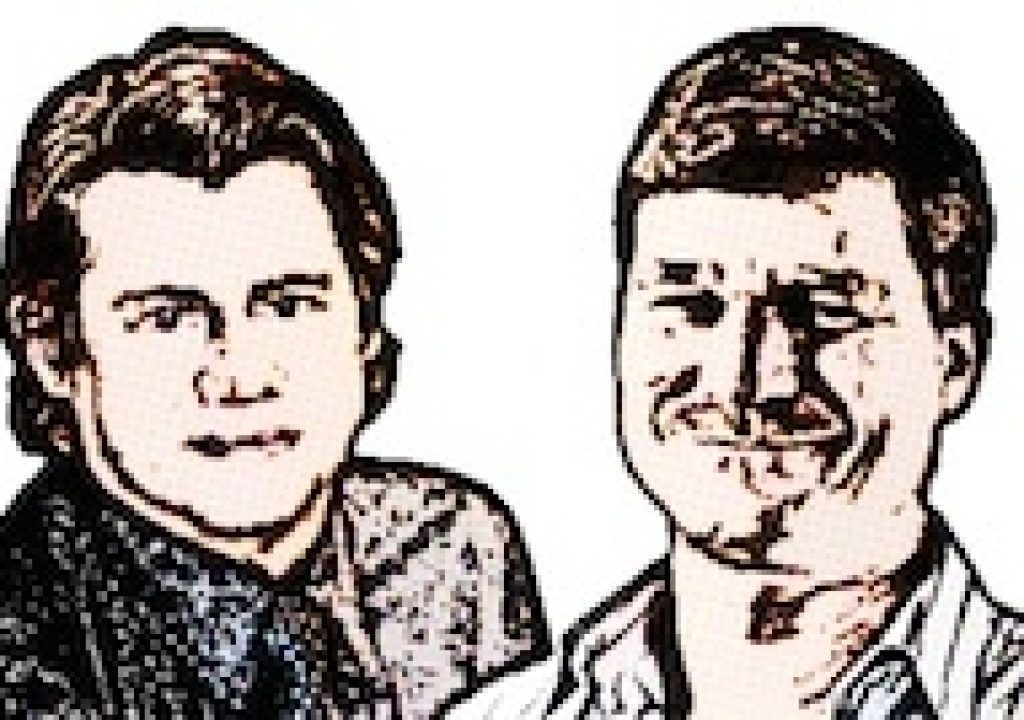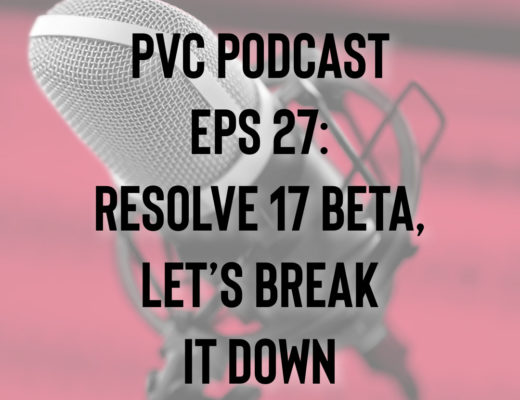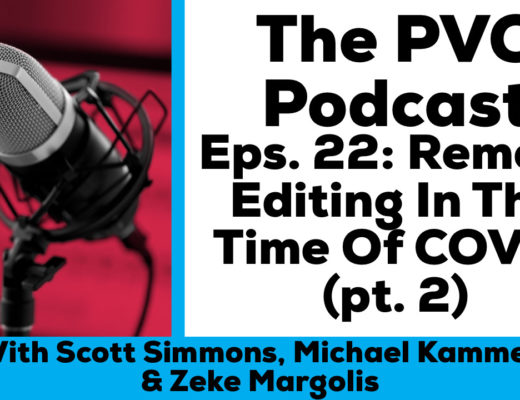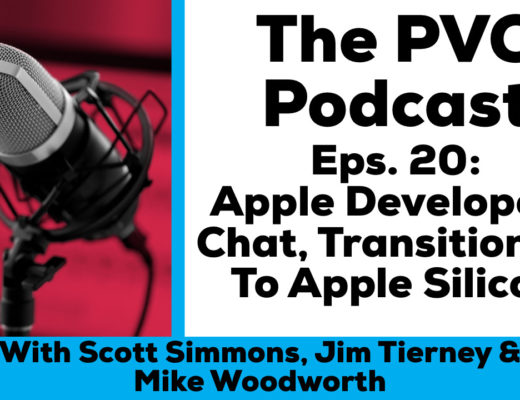To listen to the Terence and Philip Show episode #67 where Terence Curren and Philip Hodgetts discuss all things NAB 2015, from Terence and Philip’s very subjective perspectives, click the player below. A transcript of the episode itself is below the player.
Podcast: Play in new window | Download (Duration: 49:11 — 22.5MB)
Philip: You’re an editor, we know you spend most of the month in a dark cave, so just once a month, get yourself out of the dark cave, away from the solitude, and be with other editors at the Editors Lounge at Alpha Dogs. Editorslounge.com.
Gary: When we last left our heroes, they were locked into a terribly important discussion. Let’s drop in on them again as they plot the future. Now, from the Top Dogs kennel in beautiful downtown Burbank, it’s the Terence and Philip Show!
Philip: Well thank you Gary, and it’s time for another Terence and Philip Show. I’m Philip Hodgetts.
Terence: And I’m Terence Curren.
Philip: And it might be time to talk NAB 2015, since it’s just over.
Terence: Yawn.
Philip: It wasn’t one of the more exciting NABs ever, I guess. And sometimes I’m actually very thankful for that. It’s nice to have a period of consolidation. A period where we can actually learn how to use the tools that are released, get them into our hands in reasonable time, practice with them, and get workflows that everyone knows work and don’t have to be changed every time you start again, like a snowflake.
Terence: Well, yeah, that would be nice except that’s it’s never actually existed in the real world anyway, it seems like. Every show. Every single show. You get the workflow down and by the end of the series you go, “okay, we’ve got a really smooth operating machine.” Next series comes up and they’ve brought in a different camera or something, and the entire thing starts all over. It’s the “snowflake workflow.”
Philip: I should be thankful that feature film workflows in Final Cut Pro X and feature films in Premiere Pro have only very limited workflow options. (Laughs)
Terence: Yeah, that’s right. That makes your life easier.
Philip: That makes my life easier and it makes their life easier and it’s interesting to see how the editorial team from Focus, they’ve gone off to do another movie that’s being shot now. The assistant editor and a new assistant are working on another feature film using Final Cut X, there’s yet another feature at a studio going on Final Cut X that is not associated with either of those, so there’s activity, there’s other features that are working in Premiere Pro.
Terence: But I’ll bet the basic workflow is essentially the same thing they’ve always done. Features don’t change that much.
Philip: Oh yeah. It’s essential the same features, and a lot of problems associated with the workflow are simply that the studio wants things that are no longer relevant, like EDLs. These sort of deliverables are things that really don’t have to be there for the modern workflow, but they have to be there as being part of a studio workflow.
Terence: Lucky for you.
Philip: EDLX was part of the toolset. A side on that, one of the tools they featured in all of the post publicity from us is Sync-N-Link X. The irony is that Focus itself didn’t use Sync-N-Link very much. They were using Light Iron for their dailies, so Light Iron was doing the synching and the daily work. The reason I think that Sync-N-Link has got the publicity since then is what was realized during Focus is that they can do all of that in-house with Final Cut Pro X, with Sync-N-Link and with Shot Notes X. Suddenly, all of the metadata is in the project, all the clips are synced up. If you want proxies to work with, of course Final Cut can generate the proxies in the background to a central location.
Terence: But then what is Light Iron going to do?
Philip: As Michael Cioni has often pointed out, he’s very aware that the business they’re currently in, probably won’t exist in five years. He did a whole thing just two years or so about that. We’re seeing the evolution of that now. He sold the company…
Terence: …to Panavision. Good thing he sold!
Philip: I think that’s a smart move. If you know that the business you’re in has a limited future, and someone is prepared to pay you money to buy a business that has a limited future…
Terence: That’s the time to sell.
Philip: I’d be happy to cash the check. I’m not sure that it’s the wisest move on the purchaser’s side.
Terence: Well, it’s Panavision, what do you want?
Philip: I don’t know the company particularly well.
Terence: That’s another company grasping for straws. They made their entire business model…you couldn’t buy a Panavision camera,.. you could only rent them. Well, if nobody is shooting with Panavision cameras it’s a little tough. I don’t know. It’s an interesting thing.
Overall, NAB… what did I find that I thought was interesting? Cinedeck got a lot of attention because you can do insert edits into Quicktime movies, but we’d already seen that at the February Editors’ Lounge.
Philip: So that was hardly exciting and new.
Terence: Exactly. Blackmagic has a million products…okay. There wasn’t anything stunningly new. They shrunk one camera down to the point where there’s a decent competitor for GoPros now that’ll be less compressed.
Philip: If you need cinematic quality.
Terence: Yes. That’ll be nice. It’ll make my life easier, color correcting reality shows. There’s a lot of little workflow things like what you were demoing, which is a big workflow thing, but in a small area. There were drones, EVERYWHERE. Oh my God.
Philip: I made that call back in 2012 when I was doing the Solar Odyssey thing and playing with the drone. It became so obvious that software will catch up with this, and, what is it, the Solo Drone? It has programmed behaviors like swing around, or zoom back up. You know, the common drone sort of moves that you want to make that are software programmed now.
Terence: It’s like having a motion capture camera. And then you can say, “let’s do it again.” You get the same move over and over again. It’s fantastic.
Philip: It was so obvious that that was the way it was going to go that I thought I could be a leader in this field, or the software will just make the next year and half of hardline knowledge obsolete in two years time, so no. Back to metadata!
Terence: And as things are shaking out, you’d have had to get a pilot’s license. Under the new FAA rules.
Philip: Although they’ve softened on a lot of those rules now.
Terence: It’s going to be interesting to see how that works. At any rate, the first mention I heard of the drones was Solar Odyssey, with your thing, and the NAB right after that there was a little section or drones, and I saw the potential, and the danger, and the controversy that was going to come around this stuff. That was two years ago I think, and now this year, my God…every single hall had a whole bunch of drone booths. I wondered where all these guys were coming from. Certainly, every model airplane manufacturer is probably making drones now, because they see the market there, but there are more companies than that who are selling drones now. I don’t know who else is doing it.
Philip: It’s all about the software. That’s the differentiation between the drones. Anyone can put together motors, blades… it’s the electronics that control that, and then the software in turn that controls the electronics that matches the GPS and all of that. That’s what makes the difference between the drones that I was practicing on in 2012, and what we have now where we have all of the pan-and-tilt heads stabilized. And of course that technology has now come back to handheld, to I think the MoVI, that takes the pan-tilt stabilization out of the helicopter and puts it into a handheld device. So you can have two operators, one carrying, and one manipulating the camera.
Terence: That one is pretty cool. But we’re getting to the point where you’re not going to need handheld because the drones are going to be so efficient and so easy to use that…
Philip: There will be a noise factor that comes into play for awhile yet.
Terence: Yeah…though I think that even with handheld you’ve got so much noise going on that that stuff’s generally ADR’d afterwards, at least in features.
Philip: One of the shows that we try and watch is Grand Designs, and there’s an Australian version of it as well. One shot that they have has to be a drone. It finishes one of the programs. It starts inside, tracking toward the door, the camera is moving backwards as he walks toward the door, comes out through the door, outside, and then flies up 200 or 300 feet so you see the entire property. There’s no other way to get that shot. But apparently the way to do that is you actually have someone hold the drone while it’s inside, so its got the stability, move it out the door, let it go and run like hell to get out of the shot!
Terence: And there’s the band…and of course their name escapes me now, that makes the really cool music videos with the complex setups…
Philip: OK Go.
Terence: OK Go. That’s it, thank you. They did the one where they start on these little scooter things and they’re inside the building and then they go outside and the shot is following them out front, and you figure it’s a handheld or dolly, but then it starts going up, and it follows all these intricate moves going up, and then at the very end it just keeps going up and up, revealing how wide and how many people are involved in this big final shot that’s all choreographed and of course in one take.
That was a drone. I remember watching it, and until about a third of the way in I didn’t know that it was a drone yet. I thought it was a really interesting concept.
There was a movie called House, it was a horror movie back in the late 80’s, and their opening shot was phenomenal because they follow this guy out, the star… William Katt I think was the star…they follow him walking out of the house and out front, and then the camera just kind of goes up, and it goes way up into the sky, and I was like, “how in the heck did they do that?” And what they did is they had a steadicam operator leading him out, and he steps onto a hoist, basically, and that goes up, the crane lifted the steadicam operator up. So it was beautiful and smooth.
So when I’m watching this video I’m thinking maybe they did the same kind of thing, until it keeps going, and going, to where we’re past where any crane could reach. Anyway, that’s all an aside.
So the drones are taking over in a big way. FAA is having their issues. The current rules, as of two months ago that I know of, are you have to have a pilot’s license, you have to have two people so you have a pilot and a spotter. You can’t fly over people, you have to have a flight plan, which is the amazing part because you can’t file a flight plan in a day. It takes quite a while to get flight plans approved. All those limitations make it difficult for just anybody to go out and do this. That’s for commercial, but then the question becomes what makes something commercial, and there’s a guy who I guess has a lot of drone videos on YouTube, and apparently the FAA is going after him saying he makes money off of it.
Philip: And they’ll lose hand over fist. Their whole ability to regulate the drone market is in question. They probably don’t have the authority.
That’s just a preview of what Terence and Philip discussed during the podcast. Hear the rest by downloading the podcast via the links below…

Filmtools
Filmmakers go-to destination for pre-production, production & post production equipment!
Shop Now













